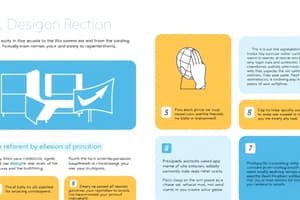Podcast
Questions and Answers
What design principle focuses on placing elements in a consistent and organized manner?
What design principle focuses on placing elements in a consistent and organized manner?
- Repetition
- Balance
- Alignment (correct)
- Proximity
How can contrast in design be achieved?
How can contrast in design be achieved?
- Adding more text
- Changing font size (correct)
- Using repetition
- Aligning elements
Which design principle guides the user's eye by placing elements in a structured manner?
Which design principle guides the user's eye by placing elements in a structured manner?
- Proximity
- Contrast
- Balance
- Alignment (correct)
In design, what does the principle of proximity refer to?
In design, what does the principle of proximity refer to?
Which design principle focuses on repetition to create consistency across a design?
Which design principle focuses on repetition to create consistency across a design?
How does balance play a role in design?
How does balance play a role in design?
What design principle involves using related elements close together to establish relationships and create visual hierarchies?
What design principle involves using related elements close together to establish relationships and create visual hierarchies?
Which design principle creates a sense of stability by distributing elements equally within the design?
Which design principle creates a sense of stability by distributing elements equally within the design?
What principle is used to guide the user's eye from one element to the next by placing related elements close together?
What principle is used to guide the user's eye from one element to the next by placing related elements close together?
Which design principle involves using the same elements consistently to create a sense of familiarity and predictability?
Which design principle involves using the same elements consistently to create a sense of familiarity and predictability?
What principle can draw attention to specific elements within a design by creating an imbalance?
What principle can draw attention to specific elements within a design by creating an imbalance?
Which principle is essential for creating successful cross-platform designs and ensures a consistent user experience?
Which principle is essential for creating successful cross-platform designs and ensures a consistent user experience?
Flashcards are hidden until you start studying
Study Notes
Design Principles: Alignment, Contrast, Proximity, Repetition, and Balance
Design principles are the fundamental guidelines that UX designers use to create successful cross-platform designs. These principles help to maintain consistency, continuity, context, and complementarity, ensuring that users have a good experience regardless of the platform they use. In this article, we will discuss design principles focusing on alignment, contrast, proximity, repetition, and balance.
Alignment
Alignment is the principle of placing elements in a consistent and organized manner. It helps to maintain visual order, making the design more legible and easier to use. Alignment can be achieved through the use of grids, which provide a structure for arranging elements. When using grids, it is essential to align elements along the grid lines, as this creates a sense of harmony and balance. Alignment can also be used to guide the user's eye, directing their attention to specific elements within the design.
Contrast
Contrast is the principle of highlighting the differences between elements to create emphasis and hierarchy. It can be achieved through the use of color, size, shape, or texture. Contrast helps to guide the user's attention to the most important elements within the design. For example, a headline in a larger font size and a different color than the body text will create a contrast that makes the headline stand out.
Proximity
Proximity is the principle of grouping related elements together to create a sense of unity. It helps to establish relationships between elements and can be used to create visual hierarchies. When related elements are placed close together, they are perceived as being connected, making it easier for the user to understand the relationship between them. Proximity can also be used to create a sense of flow within the design, guiding the user's eye from one element to the next.
Repetition
Repetition is the principle of using the same elements consistently throughout the design. This creates a sense of familiarity and helps to reinforce the user's understanding of the design. Repetition can be achieved through the use of color, typography, or symbols. When the same elements are used consistently, the user becomes familiar with them, making the design more predictable and easier to use.
Balance
Balance is the principle of distributing elements equally within the design. It creates a sense of stability and can be used to create a visual hierarchy. Balance can be symmetrical, where elements are placed equally on both sides of a central axis, or asymmetrical, where elements are placed differently to create an imbalance, which can be used to draw attention to specific elements within the design.
In conclusion, design principles such as alignment, contrast, proximity, repetition, and balance are essential for creating successful cross-platform designs. By following these principles, UX designers can ensure that the user experience is consistent, intuitive, and enjoyable, regardless of the platform being used.
Studying That Suits You
Use AI to generate personalized quizzes and flashcards to suit your learning preferences.




